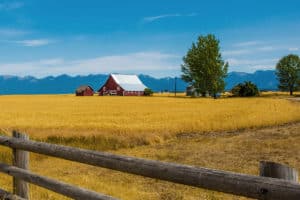The phone call came in cold, three weeks ago. A major gas company was offering $10,000 to buy a 50-foot-wide, pipeline right-of-way easement over about a half mile of timberland I own with three others.
Domestic oil and natural gas are in play from Wyoming to West Virginia. Agents for oil-and-gas companies, known as landmen, are leasing land for drilling and production. A lot of cash is being waved under a lot of noses.
Most landowners, including us, want to work a deal, because of the money. We also want to be treated fairly, and protect our property and its future value.
The written agreement between landowner (lessor) and company (lessee) governs the money and how development is conducted. Oral agreements don’t count.
Here are points for landowners to consider regarding leases.
Common interests. You and the leasing company share an interest in making money from your minerals. Both sides try to negotiate as much money from the other as possible. Companies generally get the longer end of these sticks because they are in better bargaining positions and are far more knowledgeable.
What’s fair money to the landowner? It depends on the specific time, place and current market conditions. Two years ago, we signed a lease that provided $5 per acre in rental, which was the market price in our area at that time. Today, it would bring $30 to $50/A, because the natural gas in the Marcellus shale is now in play. Five dollars was fair then, not now.
It’s easier to judge what’s obviously unfair than what’s obviously fair at any given time.
Leases might be more fair if companies would give landowners the option of riding the market like an adjustable rate mortgage. Rental and royalty formulas would be revised every five years in light of market conditions.
If you want the money from these leases, you need to give up more than the minerals. Companies want to be allowed to do what is most efficient from their perspective with your property’s surface. A landowner should consider confining these activities in a reasonable way and restricting them to certain spots. Both sides have to find a balance between what each wants and what each can live with.
Understand the words and phrases in your lease. State law and judicial interpretation establish the legal meaning of lease language. A guy like me doesn’t have a clue as to the meaning of “appurtenant above-ground facilities” on a pipeline right of way. Is it any structure the company wants to build within the right of way? Or does “appurtenant” give the company the right build a compressor off the right of way?
Before signing a lease or right-of-way easement, ask the company to write out its definition of important terms and then talk to a lawyer who knows law.
Money, I. A landowner gets money from minerals in at least two ways: rental (an annual, per-acre payment) and royalty (a percent of money earned from any production).
Both are negotiable. Landowners should know the rates others in their area have recently negotiated. This may or may not be found in the recorded leases at the courthouse. The ROW agreement proposed to me says the landowners have granted the easement “for and in consideration of $10.00.” The $10,000 never appears.
Landowner groups have sprung up around the country, such as the West Virginia Surface Owners’ Rights Organization (www.wvsoro.org) and the Natural Gas Lease Forum for Landowners (www.pagaslease.com). The latter posts current offers in Pennsylvania and West Virginia, with much other information. Both sites have informative resources and links.
Landowner groups are forming to negotiate as one over rental and royalty. Their purpose is not to monkey-wrench a deal, but to get a better one by evening the sides.
Money, II. Landowners often think about lease rentals and royalties as free money, because it’s not sweat-earned. It may be free in that sense, but it is not without cost to the landowner.
If you ever sell your surface property, you will probably keep the minerals. In that case, your price will be discounted because of the uncertainty and surface disruption — potential or actual — that development and production bring. How do you price that discount? It depends on how much disruption is, or is likely to be, involved. The more wells on your property, the more traffic, noise, road wear and aesthetic loss. Even if a buyer doesn’t care about these matters, he is likely to discount his price to the seller as much as the buyer who does.
If the current value of your property is $5,000/A, a modest five percent discount imposed by mineral leasing would reprice it at $4,750/A. On 100 acres, your lease will cost you an estimated $25,000 in estimated sale revenue.
Landowners seek answers to two questions: What is my lease worth to the company? and What is my likely net benefit over time from the terms I accept?
Time. Companies like to lease minerals for a fixed rate per acre and fixed royalty in perpetuity. An alternative is to revise both every five years.
Royalty. A common production royalty has been 12.5 percent of sale revenue less deductions. Today, leases are being signed for 12.5 to 20 percent and more. And some landowners have negotiated a percentage of gross sales, not net after deductions.
Well spacing. Whether the company has to space wells — a minimum of so many surface acres per well — or not depends on state law and the type of well.
With some wells, a company can suck out your o&g resource even if you didn’t sign a lease. With other wells, you will get a fair share of royalty even if you don’t lease. A landowner needs to know which type of well will be drilled on his land and next door.
One lease or many. As a rule, companies prefer to get all minerals under one lease. Some landowner groups suggest it might be better to negotiate individual leases for individual resources with the same company—for example, all gas down to the Marcellus shale, all gas in the Marcellus shale and all gas below the Marcellus shale. This is not a DIY project.
Roads. Your agreement should require exploration and production companies to repair all roads after using them to a condition that is “equal to, or better than” their condition before work began.
Waste and disposal. Wastes, equipment and junk should be removed from your property in a timely manner.
Use of water. Deep gas wells, I’m told, require about 50,000 barrels of water, which is used in the drilling and fracturing of underground rock. Landowners should understand the implications of use of their water.
Lines. All permanent lines should be buried. I’ve visited older fields that had metal and orange plastic lines hanging from trees and running around like spaghetti on LSD.
Specify location of wells and surface structures. Try to keep these facilities out of sight and sound of houses and likely house sites.
Conservation easement. If minerals are severed from surface ownership, you can’t put certain conservation easements on the surface unless you can show that minerals are not present or their economic value is so insignificant that they would never be produced.
Landowners who own their minerals might consider leasing them with No-Surface- Occupancy language, which keeps the Conservation-Easement door open for the future.
Liability. The offer I received said the company would be responsible for damage to my property caused by its negligence. That would exclude compensation for all non-negligent acts that diminish our surface, such as damage to crops, timber or roads. Companies should repair or compensate landowners for any significant damage they cause.
Mineral leasing is a complicated subject. I’ve just scratched the surface.
Some companies are good partners; others are less good. If the landowner wants to get the money, it’s his responsibility to become informed and make the best deal possible with whichever partner phones one morning.
This content may not be used or reproduced in any manner whatsoever, in part or in whole, without written permission of LANDTHINK. Use of this content without permission is a violation of federal copyright law. The articles, posts, comments, opinions and information provided by LANDTHINK are for informational and research purposes only and DOES NOT substitute or coincide with the advice of an attorney, accountant, real estate broker or any other licensed real estate professional. LANDTHINK strongly advises visitors and readers to seek their own professional guidance and advice related to buying, investing in or selling real estate.









Add Comment